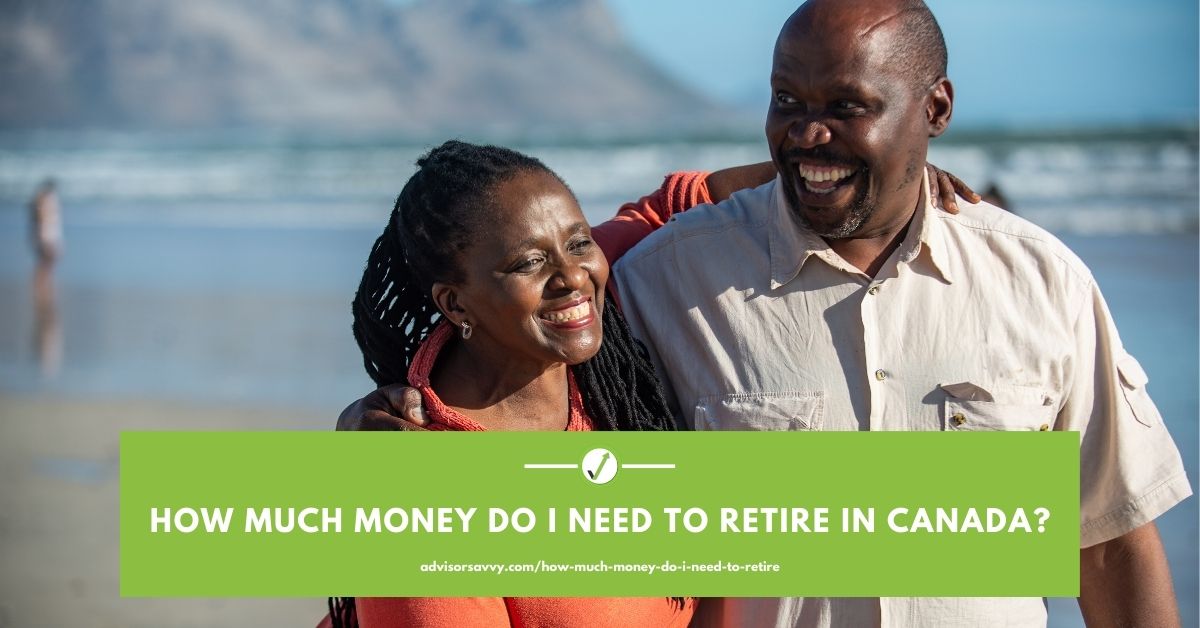
Most people look forward to retirement for the better part of their working lives. We also know that planning for retirement is an important part of any financial plan. What we don’t necessarily know, however, is exactly how much money we need to retire in Canada at a comfortable level.

According to a CIBC report from February 2018, Canadians estimate they need an average of $750,000 in personal savings to retire comfortably. CIBC also found that 32% of respondents between 45 and 64 have nothing saved for retirement, and 53% said they don’t actually know if they are saving enough.
These numbers are quite eye-opening and could indicate problems down the road. That said, you have to look at your own financial situation. It’s important to plan for retirement by determining how much you need to be comfortable.
Table of contents
What is the average retirement income in Canada?
If you have significant savings built up from decades of working, you’ll likely be in decent shape for retirement. But as we mentioned above, there are many Canadians who are simply not prepared enough.
The Canada Pension Plan (CPP) — or QPP in Quebec — is a key source of retirement income for many seniors. In January 2021, the average monthly CPP benefit was $619.75 per month. If you’re a new beneficiary, the maximum you could receive (starting at age 65) is $1,203.75.
It doesn’t take a financial wiz to know that this is hardly a liveable income — even if you’re able to access the maximum.
Meanwhile, a 2016 survey found that the average living expenses in Canada for people 65+ is just south of $60,000. This has likely gone up. That makes for one heck of a shortfall between what seniors have and what they need in retirement. What’s crystal clear is the need to determine where you may have gaps in income, and how much you’ll actually need for those post-career years.

Match to your perfect advisor now.
Getting started is easy, fast and free.
How much money do I need to retire in Canada?
The answer to this broad question will vary greatly on how you live now. Where you plan to retire and how you plan to spend your retirement are also important considerations. For example, are you planning on extensive travel or sticking close to your home and/or family? Are you planning on ageing in place or downsizing — or even moving in with family or a friend?
Use a retirement calculator to shed some light on how your personal income, savings plan, and life plans can impact your retirement savings needs.
The typical rule of thumb is that you need between 70-100% of the income you were getting before retirement to live comfortably in your post-work life. If you plan on having a mortgage in retirement, you need as much of your annual working income as possible when you retire. However, if you’re one of the lucky few without a mortgage, you need less.
How much do you need to retire at 55 in Canada?
Not everyone looks at 65 as the earliest they can retire. In fact, many people set their sights on 55 as their retirement goal age.
If that’s your goal, use a calculator like this one to see how your current income and expenses can be organized in such a way that you can retire before 65. It might not be doable, but if it is, a calculator can give you a better idea.
Retirement savings guidelines
There are a variety of well-known guidelines people follow when saving for retirement. While they all have generally the same goal, they reflect different approaches. Just keep in mind that everyone’s finances are different! Many factors determine how much you’ll need in retirement. Keep these guidelines as just that — guidelines. As always, your financial advisor can help you make a workable plan for retirement.
Rule of 10%
This rule recommends setting aside 10% of every paycheque for retirement.
Rule of 20
Not everyone agrees the rule of 10% is enough. Some, instead, suggest the rule of 20. This guideline states that for every $100 you make, you should save $20 for retirement.
Rule of 72
This rule is a calculation that looks at how long it takes your investments to double, with the same rate of interest for the length of the investment. Divide 72 by the annual rate of return, and you get a rough idea of how long it will take you to see your investment double.
Rule Of 4%
This rule looks at your planned withdrawals. Following it, your withdrawals every year should equal about 4% of what you have saved. Once you figure out what you need to live off of, you can better determine how much you need to save in total.
X25 Rule
This rule suggests that you should assume 25 years of retirement. Determine what your annual income will look like upon retirement. Multiply by 25 and that’s how much you should have in retirement savings when it’s time to stop working.
70% Rule
With this rule, consider your current income. Then, save to retire with an amount that would allow you to live off of 70% of your original income, for the remainder of your retirement.
Do I need $1 million to retire in Canada?
Kind of like hearing an 800-point credit score is a worthy goal, so too is the idea that Canadians need $1 million in savings for a comfortable retirement. That is, of course, a major over-simplification given that everyone has different expenses and expectations for how they would like to live in retirement.
Absolutely, if you save $1 million for retirement and you’re not a multi-millionaire living a life of luxury before retirement, you should be comfortable. But is it necessary? Not so fast.
To reiterate, the amount of money you need to save for retirement depends primarily on when you want to retire and what you want to do when you retire.
Getting the help of a professional is the best way of making sure your plan is solid and will get you where you want to go.
What is a retirement plan?
Winding down your working life also means a gradual end to your steady income. Lots of free time with no income can be an issue. And, of course, you still need to eat and live when you’re retired! This is where retirement planning comes in.
A well-executed retirement plan creates a strategy to replace that lost income upon retirement so that you can still put a roof over your head and live your life. It’s all about understanding how much money you need for retirement and setting a plan to get there.
What are my options for retirement planning?
There are far more ways to save for retirement than most people realize. There is (as we will discuss further down) the traditional Registered Retirement Savings Plan (RRSP) — certainly one of the most well-known, secure ways to save for retirement. In addition, there are some options you probably know about but aren’t exclusively relying on. It is important to consider all of these when thinking about how much money you’ll need.
Canadian Pension Plan (CPP)/Quebec Pension Plan (QPP)
You pay into the Canada Pension Plan your entire income-earning life. It’s designed to replace 25% of your pre-retirement income. And when you retire, you can finally reap the benefits.
You can start receiving monthly payments from the Canada Pension Plan Investment Board as early as age 60, or as late as 70. Many experts, however, recommend you start later since benefits are based on how long and how much you contributed.
That said, it’s quite clear that this benefit alone won’t be anywhere near enough for a sustainable, liveable life. Some sort of supplementary retirement savings is necessary.
Old Age Security (OAS)
The great thing about OAS is that since it comes out of tax revenues, everyone in Canada qualifies for this monthly public pension once they hit age 65. It’s true — whether or not you have ever been employed, or are currently employed. Depending on whether or not the government has enough information, you’ll either be automatically enrolled or need to apply.
Payments are based on how long you’ve lived in Canada, and start the month after you turn 65. The October to December 2021 maximum monthly payment is $635.26.
Note: Seniors 75+ will see an automatic 10% increase of OAS, as of July 2022.
The Government of Canada’s full overview of the OAS.
Guaranteed Income Supplement (GIS)
Unlike the previous two pension plans, GIS is specifically for lower-income individuals. It is a non-taxable OAS supplement for people who need it. Your income tax declarations determine whether or not you qualify.
The Government of Canada’s full overview of the GIS.
2022 CPP, OAS, and GIS Payment Dates
- January 27, 2022
- February 24, 2022
- March 29, 2022
- April 27, 2022
- May 27, 2022
- June 28, 2022
- July 27, 2022
- August 29, 2022
- September 28, 2022
- October 27, 2022
- November 28, 2022
- December 21, 2022
Pension plans
Employee pension plans come in a variety of forms. Some are self-directed, others are employer-sponsored, and some are a mixture of both. No matter the option, it’s best to take advantage of any opportunity where your employer helps you save for retirement.
Under some plans, employers exclusively contribute to a retirement plan that is vested. That means you can take it when you leave, after a certain number of years of service. It pays out in full, upon retirement — again, after a certain number of years of service.
Other plans allow you to set money aside per paycheque towards your retirement. Your employer may or may not contribute a percentage or dollar amount based on what you yourself contribute. Some employers don’t contribute to a plan, allowing you instead to create forced savings. In this case, you’d be offered the option to set aside funds into an RRSP before it ever hits your paycheque.
If you leave or get laid off from your job that has an employer pension, those funds get transferred to a Locked-In Retirement Account (LIRA), a type of registered account. You might also have the option of keeping your pension at your former company, with regular monthly payments sent to you once you retire, or transferring it to a new employer pension.
In the lead up to retirement, your LIRA must be converted into a Life Income Fund (LIF), a registered account through which you’ll receive your pension funds as retirement income.
Registered Retirement Savings Plans (RRSPs)
When thinking about how much money you need to retire, consider your Registered Retirement Savings Plan (RRSP). A savings account designed to help Canadians save money for retirement, contributions to RRSPs are protected from income tax.
Bonus: you can invest your RRSP funds in a variety of ways. Any funds earned through these investments are also protected from tax for as long as they remain invested. This allows you to grow your portfolio in time to retire comfortably.
Recommended Reading: Our RRSP blog section
Registered Retirement Income Funds (RRIFs)
A Registered Retirement Income Fund (RRIF) is a tax-deferred retirement plan that is essentially a continuation of your RRSP. While you can open an RRIF after the age of 55, once you turn 71, you must close your RRSP and convert it into an RRIF for regular, taxable retirement income. This transfer has zero tax impact.
Tax-free Savings Accounts (TFSAs)
Tax-Free Savings Accounts (TFSAs) work like any savings account. You set aside whatever money you want (up to a government-set maximum), and you can remove it whenever you want, without penalty.
The money, while in the account, accrues interest – more interest than you would see in a traditional savings account. What sets the TFSA apart is that the interest that is typically subject to taxation in an unsheltered account, is tax-free when invested in a TFSA.
Even better, while it is called a savings account — and for many people, it’s just that — almost any investment that can be held in an RRSP can go into a TFSA — think bonds, stocks, mutual funds, exchange-traded funds, options, and more. Ultimately, it’s a savings shelter that’s similar to an RRSP.
Real estate
One of the major benefits of homeownership is that it is a great vehicle for retirement savings. Many of us buy family homes that we no longer need once the kids move out. Why sit on a large property with empty rooms? Downsizing in retirement allows you to free up the equity you have in that home and use it in retirement.
ICYMI: Check out our article ‘Best Places To Retire In Canada.‘
Retirement can easily seem like a distant pipe dream. It can be hard to get in the mindset of saving for something that’s so far away. The reality, of course, is that inflation makes living with a solid income increasingly difficult.
There is no better time than the present to plan for how to manage future fixed expenses without the benefit of an income to pay for them. If you’re not sure how much to save for retirement, sit down with a financial planner to go over your goals, your expectations, and your current ability to save for the future.
Retirement will be here sooner than you think. Remove any future stress by planning for a bright future.

